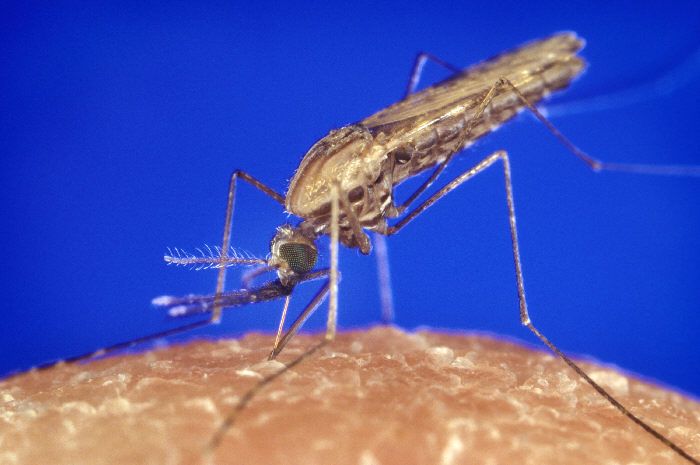
A big computer, an all-male army of insects, and a home diabetes test kit—not what you might think to bring along when going up against a mass killer. These tools, however, comprise part of the arsenal in the ongoing fight against malaria, a mosquito-borne disease responsible for over 600,000 deaths annually. The fifth annual Bay Area World Malaria Day Symposium, hosted by the nonprofit Zagaya this April, highlighted some of the progress and challenges in research on the prevention and treatment of malaria. Three trends stood out. First, researchers need to creatively work around tight cost constraints and plan for harsh field conditions. Second, academic and nonprofit malaria researchers often partner with private companies. Last, some tools, like bed nets, are actually quite low-tech, while others sound straight out of science fiction.
Dr. Gonzalo Domingo, who leads the diagnostics group at PATH, a global health nonprofit organization, points out that coming up with technical solutions is only half the battle. “If we just use everything that is available to us, we’ll make something that’s dazzling but not necessarily appropriate,” he says. Domingo’s work is an example of this principle.
Billions are at risk of infection by a strain of malaria called Plasmodium vivax, which hangs out in the liver indefinitely after infection, leading to recurring health problems and spreading the disease to new hosts. Since the 1950s, a drug called primaquine has been used to root out hidden P. vivax. But there’s a catch: primaquine has very nasty side effects for people deficient in an enzyme called G6PD. And many of the roughly 300 million G6PD-deficient people live in the malaria belt. “You have this ironic situation where the deficiency has evolved potentially to protect the population against severe malaria, but it’s now a risk barrier to getting the best possible treatment safely,” Domingo says.
Clinicians need a way to check if a patient lacks G6PD before giving that person primaquine. Though scientists have long known how to figure out if someone is G6PD-deficient, it’s not so easy to do the test cheaply, reliably, and in a range of weather conditions. Domingo is working on leveraging the technology in home diabetes monitors to inexpensively test whether or not it is safe to use primaquine.
At the UC San Francisco Malaria Elimination Initiative, Dr. Alemayehu Midekisa and Dr. Adam Bennett are using statistical algorithms and computing power from Google to create real-time maps showing how the likelihood of malaria outbreak varies across landscapes and seasons. Midekisa points out that with cloud computing, they can now “generate risk maps in a fraction of a second that would have taken weeks or months in the past.” These risk maps help planners figure out how to distribute resources like bed nets that keep mosquitoes from transmitting the disease to sleeping humans.
Researchers don’t just turn to private companies for computing power. Grant Dorsey, MD of the UCSF School of Medicine, who works on developing and testing new drugs to fight malaria, points out that public-private partnerships are important in his field. “Academics do initial bench work, but once the drug is ready for human testing, it goes to private companies with experience and funding,” he explains. “It’s really created a totally novel way of developing drugs that are desperately needed.” Domingo notes that such partnerships are often critical ingredients in malaria research, since private companies often can test and distribute products at much lower cost than nonprofits.
However, private endeavors have not historically focused on malaria on their own. ”Because malaria affects people in developing countries, it’s not a priority for drug companies,” Dorsey says. In fact, the malaria drugs in wide use today were largely developed by the US military. Yet creating new malaria drugs is imperative, because, just as with antibiotics, “resistance is almost inevitable,” Dorsey says. Developing new antibiotics is a lucrative endeavor by comparison, since antibiotics are desirable in large and potentially wealthy markets. Nonetheless, Dorsey is hopeful that research is expanding the number of antimalarial drugs.
As tools for diagnostics, risk analysis, and treatment move forward, Dr. John Marshall of the UC Berkeley School of Public Health is focusing the blood-sucking, buzzing source of malaria infections: the mosquito. One of his projects involves modeling how to wipe out the population of disease-carrying insects via genetic engineering. To do this, one has to overcome a thorny problem. If you introduce a gene that makes mosquitoes less likely to reproduce (or more likely to die), natural selection will tend to keep the gene from spreading through the population. Marshall and collaborators propose hacking into the sex chromosomes and attaching a toxin-producing gene to the X chromosome while a putting the gene for the antidote on the Y chromosome. Female offspring of the GM mosquitoes, lacking a Y chromosome, get the poison without the antidote, and die. The males survive and mate, prolifically. Marshall’s models show that the population becomes increasingly male-dominated, and ultimately crashes for lack of females to make new mosquitoes.
The researchers above comprise a sample of the many who came together at this year’s Bay Area Malaria Symposium. Hopefully, next year’s event will offer further progress—and even more novel tools for stamping out malaria around the globe.



